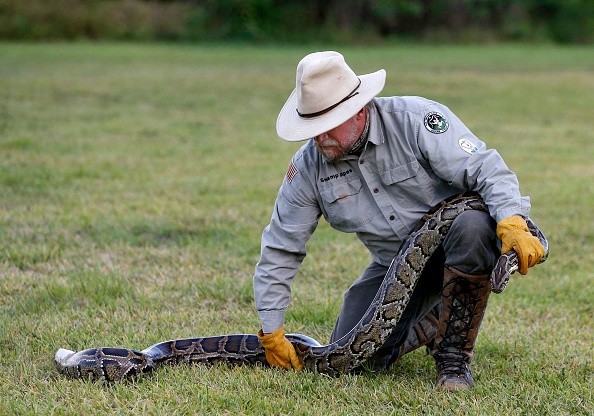One of the largest snake species in the world is the burmese python, which are invasive species in Florida and are viewed as a threat to native wildlife
Inside the bushes at the Big Cypress National Reserve in the South of Florida on Thursday night, snake catcher Josh Turner of the Everglades Python Snatchers and his wife came across a Burmese behemoth.
With just his bare hands, Turner managed to capture the 88-pound snake, and his wife recorded the entire event on camera.
Florida man use bare hands to capture massive 16-foot Burmese snake

They are native to Southeast Asia and are classified as vulnerable to extinction in their natural habitat by the International Union for Conservation of Nature, as per Newsweek.
The snakes' established populations were first noted in Florida in 2000.
These creatures are believed to have been either escaped pets or pets that have been purposefully released.
The snakes are getting more and more common; just last week, a huge female was spotted in broad daylight slithering across a tarmac road in the Everglades National Park.
Turner works as a state-employed python contractor for the South Florida Water Management District.
He has already been hunting such invasive reptiles for around four years now, but he has been around snakes his entire life.
According to American Veterinary Medical Association recommendations, the python in the video was started to turn in alive to state authorities and humanely put to death.
To help researchers learn about these problematic titans, it has recently undergone necropsy.
Ecosystems in Florida harmed through invasive pythons
One of the most alarming invasive species in Everglades National Park is the non-native Burmese python, which has developed a breeding population in South Florida, as per the USGS.
The native wildlife, that also includes mammals, birds, and other reptiles, competes with pythons for food.
Burmese pythons have been associated with significant mammal reduces in Everglades National Park.
In the remote southernmost areas of Everglades National Park, where pythons have indeed been established for the longest, native species have suffered the most severe declines.
According to a 2012 study, the numbers of raccoons, opossums, and bobcats have all decreased significantly since 1997.
Marsh rabbits, cottontail rabbits, and foxes all but vanished.
The stomachs of Burmese Pythons removed from Everglades National Park and other Florida locations regularly contain the mammals whose populations have declined most dramatically.
Near the water's edge, which is a place where pythons frequently forage for prey, raccoons and opossums frequently go on food hunts.
Human fatalities from non-venomous snakes are extremely rare, with only one or two reported each year worldwide.
All known constrictor-snake fatalities in the United States have occurred as a result of captive snakes; these include deaths of snake owners who were intentionally engaging with their pet and deaths of small children or infants in homes where a snake was kept captive as a pet.
In Florida, no humans have been killed by wild Burmese pythons. Overall, the risk of an attack is extremely low.
Related Article: New York Man Arraigned After Smuggling Pythons in his Pants at the Canadian Border
© 2025 NatureWorldNews.com All rights reserved. Do not reproduce without permission.





